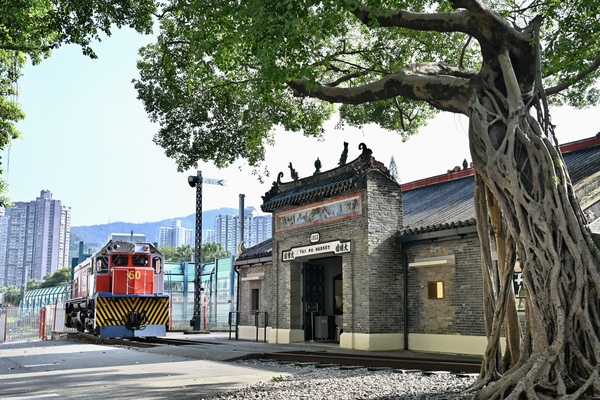Retired Train Restored To Former Glory

Diesel Electric Engine No. 60 "Peter Quick" or L60, which began operation in 1974, was one of the last fleet of diesel electric engines introduced to Hong Kong for the Kowloon-Canton Railway.
Operating on the East Rail Line, L60 had witnessed the golden era of railway freight services between Hong Kong and the Mainland. Following the full electrification of the Kowloon-Canton Railway in 1983, L60 was withdrawn from passenger services and switched to hauling freight and maintenance trains.
After serving Hong Kong for nearly half a century, L60 was retired from service in 2021 and handed over to the Railway Museum in 2023 for its permanent collection and display by the MTR Corporation (MTRC), with the conservation work supervised by the Conservation Office of the Leisure & Cultural Services Department (LCSD).
Painstaking work
Fabricated primarily from metal materials, L60 was subjected to prolonged exposure to outdoor environments throughout its service life. As a consequence, its iron parts inevitably suffered from corrosion and deterioration of its protective coating.
In preparation for its relocation to the museum, in June last year, the LCSD team conducted extensive conservation work and applied a protective coating to the locomotive at the MTR Lo Wu Locomotive Running Shed, to minimise the engine’s rate of deterioration and ensure its suitability for outdoor display.
“One major challenge in the conservation process lay in accurately matching the paint colours for the body,” explained Leisure & Cultural Services Department Assistant Curator II (Conservation) Jacky Wong.
“To restore the most accurate colours after prolonged exposure to rain and sun required repeated matching with the reference data provided by the MTRC. However, certain degrees of colour difference still existed, while the most difficult colour to retouch, blue, can only be found in concealed, non-visible areas of the engine.”
After two months of painstaking work, the conservation efforts were completed. However, transporting the engine to the museum for display posed a fresh set of challenges.
Major move
The team started planning a transportation route for the engine over a year ago and used computers to simulate the entire transportation and assembly process. The engine’s body and bogies had to be transported separately, with the move taking place late at night.
Particular caution had to be exercised close to the museum, as the road adjacent to it is exceedingly narrow. Upon arrival, the locomotive was reunited with its bogies.
“We needed to consider the loading capacity of the road and the height of the transportation crew.
“It was because there is some limitation when you transport goods or transport something on the roads of Hong Kong. So, by considering all these factors, we concluded that we needed to separate the bogies from the locomotive body to meet all the requirements for the transportation,” noted Leisure & Cultural Services Department Assistant Curator I (Conservation) Jimmy Wong.
Historically meaningful
Following the installation of the No. 60 engine, the museum now boasts two diesel-electric engines in its collection. It believes the latest addition to its exhibits will give visitors a better understanding of the historical development of Hong Kong’s railways.
“It witnessed a series of milestone events in the history of Hong Kong, such as the prospering of the railway freight service between the Mainland and Hong Kong in the 1980s and 1990s,” Leisure & Cultural Services Department Assistant Curator I (Hong Kong Railway Museum) Sunny Chan said.
“We want to preserve this to raise the public's interest in the history of Hong Kong’s railways. For the museum, we can introduce the significance of how the railway freight service can help the development of the Hong Kong economy as well as the tighter relationship between Hong Kong and the Mainland.”
New Hub Helps Green Tech To Flourish
Last month, the Hong Kong Science & Technology Parks Corporation, or HKSTP, transformed its InnoCentre in Kowloon ... Read more
MICE Tourism Gains Momentum
Ballroom inspections and mahjong sessions may not be what automatically springs to mind when you consider Hong Kong’... Read more
Game Startups Reach New Level
The global video game industry is highly competitive, requiring effective marketing for success. The Hong Kong Game En... Read more
Breast Milk Donations Save Lives
Last April, Ida Chan welcomed her son into the world. He was born a kilogramme lighter than expected, and Ida decided ... Read more
HK Reaches For The Moon
The beauty and mystery of the Moon have captivated the human imagination for millennia. Channelling that fascination i... Read more
Creating Disability-inclusive Jobs
Nestled in the Museum of the War of Resistance & Coastal Defence, Madam Hong Cafe enjoys the spectacular views of ... Read more

